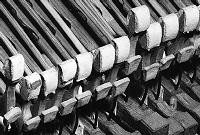 Fig. 3. Hammers of 1720 Cristofori piano (By permission of the Metropolitan Museum of Art).
Fig. 3. Hammers of 1720 Cristofori piano (By permission of the Metropolitan Museum of Art).

[<- Previous] [Contents of this lecture] [Next ->]
The hammers of a piano not only define the instrument: they also are among the most important factors in determining its tone quality. The hammers in the 1720 piano have wooden heads which are covered with leather (Fig. 3). Modern piano hammers are covered with wool felt that is compressed and stretched over a wooden molding (Fig. 4). Often two layers of felt are used. In Fig. 5 a modern hammer with the outer felt loosened is shown.
 Fig. 3. Hammers of 1720 Cristofori piano (By permission of the Metropolitan Museum of Art).
Fig. 3. Hammers of 1720 Cristofori piano (By permission of the Metropolitan Museum of Art).
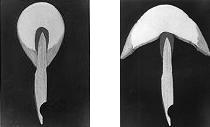 Fig. 4 and 5. Modern grand piano hammers as normal and with outer felt loosened.
Fig. 4 and 5. Modern grand piano hammers as normal and with outer felt loosened.
A view of the action from the 1720 piano is seen in Fig. 6. Cristofori glued his hammers onto wooden shanks as we are still doing today. In a modern grand piano the mechanical system of the hammer head on its somewhat flexible shank exhibits a major vibrational mode around 260 Hz as installed in the piano. This mode is not normally audible in the lower half of the piano's compass, but it can be heard in the treble register, as part of the "knock" component of the tone, beginning somewhere around A4 (key 49), and can be shown to affect noticeably the tone of the instrument. An improvement in the tone can sometimes be obtained by shifting the frequency of this resonance. The motion of the hammer as it contacts the strings is very complex, and is only recently becoming clear (Hall 1986, Hall 1987a, 1987b, Hall & Clark 1987, Boutillon 1988, Hall & Askenfelt 1988).
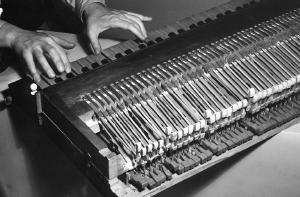 Fig. 6. Cristofori action being played (By permission of the Metropolitan Museum of Art)
Fig. 6. Cristofori action being played (By permission of the Metropolitan Museum of Art)
The hammers of the Cristofori piano are all about the same size. In a modern piano, the size and weight of the hammers increase from treble to bass in order to achieve the best compromise between tone quality, loudness, and playability. Fig. 7 shows typical hammer head weights for a modern grand piano.
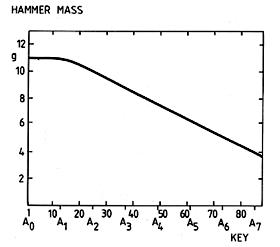 Fig. 7. Typical weight curve for modern grand hammer heads.
Fig. 7. Typical weight curve for modern grand hammer heads.
The largest bass hammers may weigh around 11 grams. The smallest treble hammers may weigh as little as 3.5 grams each. Somewhat more output could be obtained at the extreme treble end of the scale if the hammers were somewhat lighter, but this would increase manufacturing problems. In the bass, tones having somewhat more fundamental energy could be obtained by using heavier hammers but then the piano would become harder to play. An increase in hammer weight can be counterbalanced statically by installing additional lead weights near the fronts of the key levers so that the force required to depress a key very slowly will remain at its nominal value (usually around 50 grams). However, this cannot compensate dynamically for increased hammer mass. Key velocities corresponding to higher musical dynamic levels can require a finger force corresponding to several kilograms, and the value of this force increases noticeably with an increase in hammer weight.
The heavier a piano hammer is, the longer it will stay in contact with the string(s). There is a critical region of the piano's compass, between about G4 and G6 on the keyboard. Within this range the contact time of the hammer against the strings becomes equal to the roundtrip travel time for the initial pulse on the strings (Benade 1976). Below this range the hammer leaves the strings before the arrival of the first major reflection from the far end; above this range the hammer normally is still in contact. If the hammer is still in contact at the time of the first reflection, losses occur that decrease the output of the piano and may cause an undesirable quality of tone. In order to produce a graceful tone within this critical range, it is important to have an optimum hammer striking position along the strings, to have the hammer strike all of the strings of a note equally, and to keep the hammers from being too heavy. These factors are interdependent. If the hammers in the treble are too heavy, the tone will not be as loud. If the hammers of the 1720 piano were to be used in a modern instrument, the tone of the bass and middle registers would sound too thin and bright, and the treble tone probably would be harsh.
The hardness of a piano hammer directly affects the loudness, the brightness, and the overall tone quality of the instrument. In order to produce the best tone, each hammer must have its hardness within a certain range. Also, the hardness should have a gradient such that the string-contacting surface is softer than the inner material. If there is no gradient, the result can be poor tone or undesirable noise components. In Fig. 8 a special tool called a durometer is shown in use to measure the hardness and indicate the gradient of a hammer. This measurement can indicate whether the hammers have the right hardness to make a good piano tone. You could also find this out just by listening to the piano, if the hammers were already in place. But by measuring the hardness first it can be determined in advance whether the hammers can sound good, and it will be indicated how much work will be required to voice them.
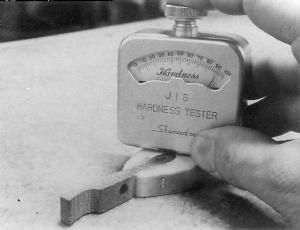 Fig. 8. Durometer in use to measure hammer hardness.
Fig. 8. Durometer in use to measure hammer hardness.
Fig. 9 shows the measured hardness for three different hammers of similar size and weight. To demonstrate the relation between hardness and tone quality I have made a recording of the tone produced by each of these hammers when installed at G5 (key 59) in the same piano (sound example 2). First you will hear the softest hammer played six times, then the harder hammer, and finally the hardest hammer. (The amount of difference you hear in the tone may depend on where you are sitting in relation to the loudspeakers.) As I hope you can hear, the softest hammer produces a pleasant tone that is perhaps a bit too soft (dark); the middle hammer produces a significantly brighter and louder tone, and the hardest hammer produces a still brighter but somewhat harsh tone that contains excessive noise components.
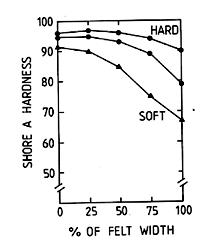 Fig. 9. Shore A hardness for three hammers.
Fig. 9. Shore A hardness for three hammers.
The optimum hardness for a hammer varies widely with its keyboard position. In order to produce tones of uniform loudness all across the scale, the extreme treble hammers must be much harder than the middle or bass hammers. The need to make the hammers harder in the treble usually begins, probably not by coincidence, in the critical region where the roundtrip time becomes equal to the hammer-string contact time.
Fig. 10 indicates approximately how the relative hardness of hammers should vary across the scale in order to produce tones of equal loudness for an equal key effort. Of course the optimum value for hardness also depends on how bright a tone the listener prefers, so this graph gives only a general indication.
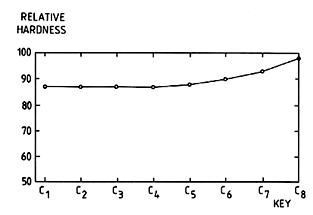 Fig. 10. Approximate relative hardness of piano hammers for equal loudness.
Fig. 10. Approximate relative hardness of piano hammers for equal loudness.
Hammers can be "voiced" by a skilled piano technician to make them harder or softer, in order to produce the best tone and smooth response from note to note. In voicing, the felt may either be softened by piercing it with needles at certain carefully chosen locations, or it may be hardened, either by filing away the soft outer felt with sandpaper, or by applying a chemical hardening agent. Voicing has little measurable effect on the lower partials of bass tones. In the treble, all of the partials are affected.
Good hammers, properly voiced, are necessary to make a fine piano, but they are not sufficient. The other parts of the instrument are at least equally important. The hammers merely provide the exciting force for the strings. A bad piano equipped with even the best hammers will still be judged a bad piano.
[<- Previous] [Top] [Contents of this lecture] [Next ->]
This lecture is one of Five lectures on the Acoustics of the piano
© 1990 Royal Swedish Academy of Music